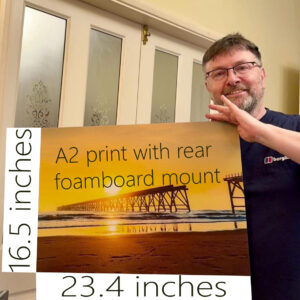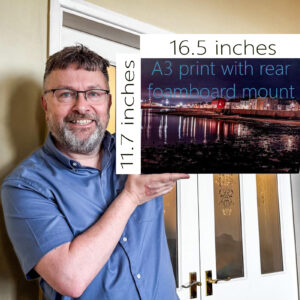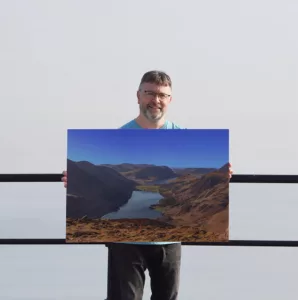FAQs
Where am I based?
I work from home on evenings and weekends, and sometimes meet customers in person on print deliveries local to me free of charge. I’m happy to organise drop off’s and around my home town of Hartlepool. I plan to promote and showcase my images in person in weekend markets in the next 12 months, and my blog will update on this. I’m happy to arrange a call or teams call to discuss.
Standard print sizes and what I offer?
My goal is for my prints and canvases/wall art to look as nice on your wall as through my camera lens.
Below are some examples of my A-Size prints (back mounted) that I often provide to customers, to gather an impression of each size.
A2 (23.4 x 16.5 inches.

A3 (16.5 x 11.7 inches)

An A1 print* (much larger, approx. 33 x 23 inches) is pictured below and is big enough to immerse & impress, even within a larger living room or many office/boardroom spaces.

*A1 size print
In addition to printing ‘A-sizes,’ which in landscape-style shots like those above are approximately 41% wider than they are tall, I offer a variety of other sizes that are carefully matched to each photo. This ensures that cropping is rarely necessary while maintaining the proportional balance between height and width.
Available sizes range up to 45″ x 30″, including (in inches): 10″ x 8″, 12″ x 8″, 16″ x 12″, and 18″ x 12″—as seen in the Gallery-Grade Ultra Fine Print, which truly pops from the paper and is currently being prepared below, titled The Pier .

Feel free to email me with any questions or technical requirements, or to request a great quality value Hartlepool-area art quote from my photo stock photo collection for your commercial premises.
Will Steve Lord Photography offer other print products in the future?
I hope those who kindly follow my work can visit revisit this site and my Steve Lord Photography Facebook page at least monthly, to find updates and news. New product types and collections will also be listed be listed.
Do I want or need Fine Art Prints when C-Type prints are much cheaper?
My traditional Lustre print range is created using light-sensitive photographic paper, which is exposed to light and then developed chemically through laser-printing technology. My Gallery-Grade Ultrafine Prints range, on the other hand, follows an ultra high-quality inkjet printing process, where tiny, intricate ink jets scatter patterns of ink onto premium paper or canvas.
While inkjet printing can outperform laser printing in terms of photographic quality and longevity, the costs and time required for printing and preparation are significantly higher with inkjet prints. For many customers, I find that my professional Traditional Lustre prints are highly regarded. As they offer excellent value for money, they are often considered more than sufficient quality and detail for their needs. The majority of the prints I create are still from this range.
When critically evaluating prints, the superior choice is my Gallery-Grade Ultrafine Prints, which offer ultra-low reflection, higher detail, a wider and richer colour range, and greater tonal depth—the contrast between the darkest black and the whitest white. These prints also meet museum-quality long-term archival standards and are produced on heavier papers with refined textures that enhance both appearance and feel. Additionally, Fine Art inkjet papers provide increased sustainability, as they are derived from cotton—whereas traditional photographic papers are made from wood pulp sourced from trees.
Will prints have a white border, or be printed to the edge of the paper?
My personal preference is the capturing energy of a scene and feeling the drama and impact, the vibrance from corner to corner. For me I normally envisage a scene as intended for edge-to-edge (borderless) prints. This is my standard style and approach, and comes as standard with print orders, though I can supply images with white borders if requested, at no extra cost. Where so, please request by email white print borders and specify in either: 1/4″ 1/2″ 3/4″ 1″ or 1.5″. Thanks in advance.
What about framing prints?
Framed prints of my town are a future planned product line. Prior to this, I am happy to help and advise on framing needs to fit my images. Please get in touch with any specific sizing/framing query that relates to a future order, and I will be happy to support.
For general framing advice based on a typical print size (12″ x 8″), consider the following options. If you are looking to frame your print, you can use a standard 12″ x 8″ frame without a front mount. Alternatively, if you prefer to mount the print within a larger frame for greater visual impact, below are two suggested sizes—though there are no strict rules.
Frame and outer front mount: 16″ x 12″—for a modest upscale effect. Inner mount opening: At or around 11.75″ x 7.75″, ensuring it is slightly smaller than the 12″ x 8″ image to hold it securely and prevent edge gaps. Border: 2″ on each side, fitting within the required 16″ x 12″ frame dimensions.
Frame and outer front mount: 20″ x 16″—ideal for a centrepiece or gallery-style print, creating a dramatic and attention-grabbing effect in a room. Inner mount opening: At or around 11.75″ x 7.75″, ensuring it is slightly smaller than the 12″ x 8″ image to securely hold it in place and prevent edge gaps. Border: 4″ on each side, fitting perfectly within the required 20″ x 16″ frame dimensions.
